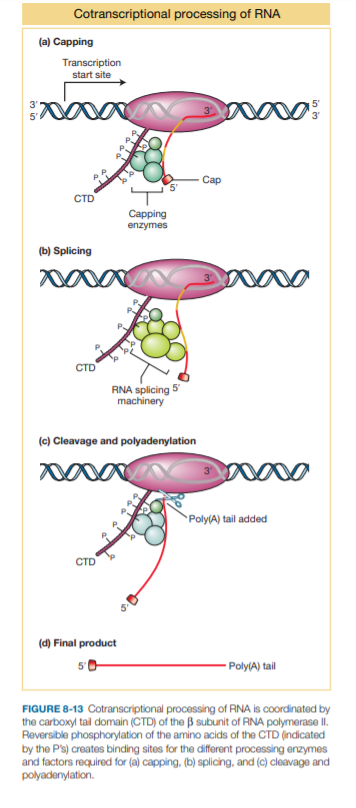Cotranscriptional processing of RNA (a) Capping Transcription start site Cap CTD Capping enzymes (b) Splicing CTD RNA splicing 5 machinery (c) Cleavage and polyadenylation Poly(A) tail added (d) Final product - Poly(A) tail FIGURE 8-13 Cotranscriptional processing of RNA is coordinated by the carboxyl tal domain (CTD) of the B subunit of RNA polymerase II Reversible phosphorylation of the amino acids of the CTD (indicated by the P's) creates binding sites for the different processing enzymes and factors required for (a) capping, (b) splicing, and (c) cleavage and polyadenylation.
Cotranscriptional processing of RNA (a) Capping Transcription start site Cap CTD Capping enzymes (b) Splicing CTD RNA splicing 5 machinery (c) Cleavage and polyadenylation Poly(A) tail added (d) Final product - Poly(A) tail FIGURE 8-13 Cotranscriptional processing of RNA is coordinated by the carboxyl tal domain (CTD) of the B subunit of RNA polymerase II Reversible phosphorylation of the amino acids of the CTD (indicated by the P's) creates binding sites for the different processing enzymes and factors required for (a) capping, (b) splicing, and (c) cleavage and polyadenylation.
Biochemistry
6th Edition
ISBN:9781305577206
Author:Reginald H. Garrett, Charles M. Grisham
Publisher:Reginald H. Garrett, Charles M. Grisham
Chapter30: Protein Synthesis
Section: Chapter Questions
Problem 12P
Related questions
Concept explainers
Oogenesis
The formation of the ovum (mature female gamete) from undifferentiated germ cells is called oogenesis. This process takes place in the ovaries (female gonads). Oogenesis consists of three stages known as the multiplication phase, growth phase, and maturation phase.
Cell Division
Cell division involves the formation of new daughter cells from the parent cells. It is a part of the cell cycle that takes place in both prokaryotic and eukaryotic organisms. Cell division is required for three main reasons:
Question
How do you know that the events in Figure 8-13 are occurring in the nucleus?

Transcribed Image Text:Cotranscriptional processing of RNA
(a) Capping
Transcription
start site
Cap
CTD
Capping
enzymes
(b) Splicing
CTD
RNA splicing 5
machinery
(c) Cleavage and polyadenylation
Poly(A) tail added
(d) Final product
- Poly(A) tail
FIGURE 8-13 Cotranscriptional processing of RNA is coordinated by
the carboxyl tal domain (CTD) of the B subunit of RNA polymerase II
Reversible phosphorylation of the amino acids of the CTD (indicated
by the P's) creates binding sites for the different processing enzymes
and factors required for (a) capping, (b) splicing, and (c) cleavage and
polyadenylation.
Expert Solution
This question has been solved!
Explore an expertly crafted, step-by-step solution for a thorough understanding of key concepts.
Step by step
Solved in 2 steps

Knowledge Booster
Learn more about
Need a deep-dive on the concept behind this application? Look no further. Learn more about this topic, biology and related others by exploring similar questions and additional content below.Recommended textbooks for you

Biochemistry
Biochemistry
ISBN:
9781305577206
Author:
Reginald H. Garrett, Charles M. Grisham
Publisher:
Cengage Learning

Biology 2e
Biology
ISBN:
9781947172517
Author:
Matthew Douglas, Jung Choi, Mary Ann Clark
Publisher:
OpenStax

Biochemistry
Biochemistry
ISBN:
9781305577206
Author:
Reginald H. Garrett, Charles M. Grisham
Publisher:
Cengage Learning

Biology 2e
Biology
ISBN:
9781947172517
Author:
Matthew Douglas, Jung Choi, Mary Ann Clark
Publisher:
OpenStax